Modern manufacturing is driven by precision, efficiency, and flexibility—and at the heart of this revolution lies CNC machining. Among all types of CNC machines, multi-axis CNC machining stands out as one of the most powerful tools for producing high-precision and complex components in a single setup.
This article dives into what multi-axis CNC machining is, how it works, why it matters, and how to choose the right setup for your specific needs.
What Is Multi-Axis CNC Machining?
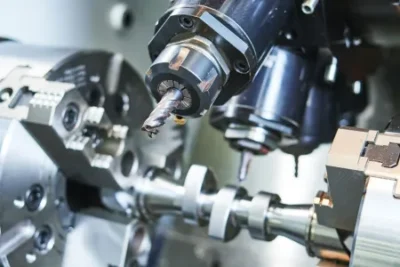
Multi-axis CNC machining refers to any CNC process where the cutting tool or the workpiece moves in more than three directions.
A typical 3-axis machine moves the cutting tool along the X, Y, and Z axes. Multi-axis machines add rotary motion—typically referred to as A, B, or C axes.
Machines with 4-axis, 5-axis, or even 12-axis capabilities allow simultaneous multi-directional movement. This is ideal for parts with undercuts, deep cavities, or organic contours.
How Does Multi-Axis CNC Work?
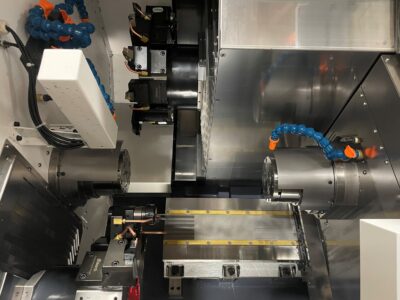
If you’ve worked with a regular CNC machine before, you probably know it moves the cutting tool in three directions—left and right (X), forward and backward (Y), and up and down (Z). That’s what we call a 3-axis machine.
Now, imagine being able to tilt and rotate the part—or even the tool itself—while it cuts. That’s the magic of multi-axis CNC machining.
So What’s the Big Difference?
In a 3-axis machine, the tool only moves in straight lines. That’s fine for flat parts or basic shapes. But what if you need to machine curves, angles, or multiple sides of a part without stopping the machine? That’s where multi-axis comes in.
Multi-axis machines add extra directions—called rotary axes—which let the tool or the part spin and tilt.
Think of it like adding a wrist and elbow to a robotic arm:
The A-axis usually rotates around the X-axis
The B-axis rotates around the Y-axis
The C-axis spins around the Z-axis
Some machines rotate the cutting tool, while others rotate the part itself—or both!
Who Moves—The Tool or the Part?
That depends on the machine design:
On some machines, the cutting tool moves and tilts
On others, the part spins on a rotary table
Advanced machines let both move at the same time
This combo of movements lets the tool reach tight spots, odd angles, and curves—without flipping the part manually.
Real-Life Example
Let’s say you’re making a turbine blade. It has curves, twists, and surfaces on all sides. With a 3-axis machine, you’d need to stop the machine, reposition the part, and start again—multiple times. But with a 5-axis machine, the tool can move all around the part in a single setup.
That means:
Less setup time
Higher precision
Better surface finish
Fewer chances for human error
Key Components of Multi-Axis CNC Machines
Cutting Tool – The Part That Does the Work
Think of the cutting tool as the “knife” of the machine. It’s the part that spins and cuts material off the workpiece (that’s your metal or plastic part).
Depending on what you’re making, the cutting tool could be a drill bit, an end mill, or a special tool designed for things like threading or engraving.
🔧 Why it matters:
Different tools give you different shapes and surface finishes. And in multi-axis machining, the tool can reach the part from multiple angles!
Main Spindle – The Tool Holder and Spinner
The spindle is like the motorized arm that holds the cutting tool. It rotates the tool at high speeds—sometimes thousands of revolutions per minute (RPM).
In multi-axis machines, the spindle doesn’t just spin—it might move up and down (Z-axis) or even rotate (C-axis) to help cut from tricky angles.
⚙️ Why it matters:
The spindle determines how fast and accurately your tool cuts. A strong spindle = better precision.
Sub-Spindle (or Pickoff Spindle) – The “Helper Hand”
Some multi-axis machines have a second spindle, called a sub-spindle or pickoff spindle. This one grabs the part after the main spindle is done with one side, and flips it to work on the other side—without stopping the machine.
🤝 Why it matters:
It saves time and avoids mistakes from re-positioning the part manually.
Rotary Table or Trunnion – The Turntable for Parts
This is where the “multi-axis” magic really happens. A rotary table can spin the part in different directions (usually A, B, or C axes).
It tilts or rotates the workpiece so the cutting tool can reach around curves, holes, or angled surfaces—all without moving the part by hand.
🔄 Why it matters:
You can cut multiple sides of a part in a single setup, which saves time and boosts accuracy.
Control Panel – The Machine’s Brain
This is where the operator loads the machining program, sets speeds, and controls the whole process. It looks like a screen with buttons, knobs, and maybe even a USB port to upload files.
Most multi-axis machines use G-code, which tells the machine exactly how to move the tool.
🧠 Why it matters:
If the program is wrong, the part will be wrong—so the control panel is where all the magic begins.
Coolant System – Keeps Things from Overheating
When you’re cutting through metal at high speeds, things can get really hot. That’s where the coolant system comes in. It sprays liquid on the tool and workpiece to reduce heat and flush away chips.
💧 Why it matters:
Cool tools last longer and cut better. Plus, it prevents overheating, which can ruin your part.
Axis-By-Axis Breakdown
| Axis Count | Additional Axes | Description |
| 3-Axis | X, Y, Z | Basic CNC milling for flat surfaces and simple contours |
| 4-Axis | A | Adds rotary movement around X-axis—ideal for cylindrical parts |
| 5-Axis | A, B (or C) | Enables full 3D machining with fewer setups |
| 6-Axis | A, B, C | Rotary movement in all directions; improved precision and speed |
| 7-Axis+ | Add E or extra arms | Advanced systems used in aerospace and medical for extreme complexity |
Benefits of Multi-Axis CNC Machining
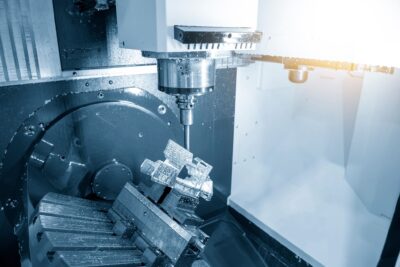
Less Setup, More Output
With 3-axis machines, you often have to stop, flip the part, and start again. That means more time, more mistakes, and more operator work.
🛠 Multi-axis machines do it all in one go.
You load the part once, and the machine tilts, rotates, and reaches every angle it needs—automatically.
👉 Result: Faster jobs and fewer chances for errors.
Make Super Complex Parts
Got a part with curves, holes at weird angles, or lots of details? No problem.
Multi-axis machines can move in multiple directions at once. That means they can handle complicated shapes that 3-axis machines simply can’t.
👉 Result: You can design and make more advanced parts without compromise.
Better Accuracy, Better Quality
Each time you move or reset a part, you risk losing precision. With multi-axis CNC, the part stays in place, and the machine does all the movement.
That leads to tighter tolerances and consistent results—perfect for industries like aerospace, medical, and automotive.
👉 Result: Less rework and higher-quality components every time.
Save Time on Every Job
Multi-axis machining speeds things up:
You don’t have to change setups
You use shorter, more rigid tools (less vibration)
The cutting paths are more efficient
All of this means faster cycle times—and that adds up fast when you’re making hundreds or thousands of parts.
👉 Result: Faster production = lower costs per part.
Smoother Surface Finish
Fewer setups = fewer tool marks. Plus, multi-axis machines can cut in smooth, sweeping motions, which helps avoid rough edges or visible tool paths.
👉 Result: A cleaner, more professional finish—often without extra polishing.
Less Labor and Fixturing
With fewer setups and repositioning, operators don’t have to babysit the machine as much. Also, you don’t need complex jigs and fixtures to hold the part.
👉 Result: Lower labor costs and faster changeovers.
Shorter Tools = Longer Tool Life
Since the tool can move to reach tricky angles, you don’t need to use long, flexible tools. Shorter tools are stronger and more stable, which means they last longer and cut better.
👉 Result: Fewer tool changes and less downtime.
Supports Mass Production
If you’re making large batches of parts, multi-axis machines can help you do it faster and more consistently—without sacrificing quality.
👉 Result: High-volume production without stress.
Quick Summary: Why Multi-Axis Rocks 🚀
| Benefit | What It Means for You |
| One setup per part | Less time wasted, fewer errors |
| Complex geometry made easy | You can design whatever you want |
| Higher precision | Every part comes out just right |
| Faster production | More parts in less time |
| Better surface quality | No need for extra polishing |
| Less fixturing | Simpler tooling and fewer costs |
| Longer tool life | Save on tools and maintenance |
| Great for large orders | Perfect for batch manufacturing |
Industry Applications of Multi-Axis CNC
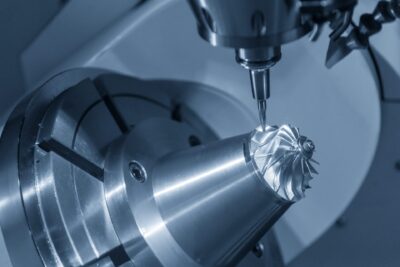
Aerospace
Structural frames, turbine blades, landing gear
High-strength alloys and lightweight materials
Medical
Surgical instruments, orthopedic implants, dental devices
Requires ultra-high precision and biocompatible materials
Automotive
Engine blocks, transmission housings, suspension components
Mass production + high consistency = perfect fit
Defense & Military
Firearms components, aerospace-grade parts
Works well with titanium and hardened steel
Electronics
Enclosures, heat sinks, connectors
Often paired with post-processing like anodizing
Jewelry & Artistic Industries
Custom engravings, intricate patterns, fine detailing
How to Choose the Right Multi-Axis CNC Machine
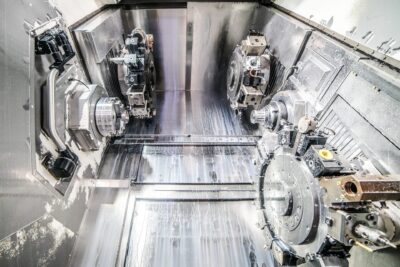
Set a Realistic Budget
Higher-axis machines cost more—not just upfront but also in maintenance and training.
Know Your Part Complexity
Simple shapes = 3-axis
Contours or angled holes = 5-axis
Simultaneous machining on both sides = 9+ axis
Software Compatibility
Make sure your CAM software supports multi-axis toolpaths and post-processing for your machine brand.
Skilled Operators & Programmers
Higher-axis machines require trained personnel for programming and running jobs.
In-House or Outsource?
For small businesses, outsourcing to a reliable CNC machining service might be more cost-effective than purchasing and maintaining a 5- to 12-axis machine.
Expert Tips for Better Multi-Axis Machining
Always simulate toolpaths in your CAM software
Use shorter tools when possible
Monitor tool wear closely—multi-axis work increases tool engagement
Invest in rigid fixturing to minimize vibration
Don’t skip coolant management—it’s critical for deep cuts and high speeds
Keep your post-processor updated for the latest G-code commands
Conclusion
Multi-axis CNC machining is a game-changer for manufacturers across industries. It allows complex parts to be made faster, with fewer errors, and less human labor.
From 3+2 setups to full 12-axis machines, this technology offers unmatched flexibility and productivity. Whether you’re in aerospace or medical, automotive or electronics, understanding and leveraging multi-axis machining can put your products—and your business—ahead of the curve.

